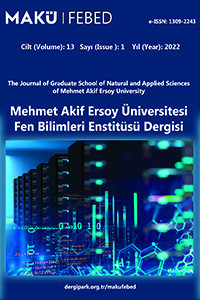Güç Akışı Analizini Öğrenmede PowerWorld Simülatör Kullanımı: Bilgisayar Destekli Bir Görselleştirme Aracı
Eğitim, güç akış analizi, güç sistemleri, PowerWorld
Use of PowerWorld Simulator in Learning Power Flow Analysis: A Computer-Aided Visualization Tool
Education, power flow analysis, power systems, PowerWorld,
___
- Acha, E., Agelidis, V., Anaya-Lara, O., Miller, T.J.E. (2002). Power electronic control in electrical systems. Oxford, UK: Newnes.
- Afolabi, O.A., Ali, W.H., Cofie, P., Fuller, J., Obiomon, P., Kolawole, E.S. (2015). Analysis of the load flow prob-lem in power system planning studies. Energy and Power Engineering, 7(10): 509–523.
- Carbajal, C., Gast, A., Fleck, M., Podolsky, S.P., Berry, F., Dinkelaker, J., Patel, K., Jha, A., Grigg, C. (2005). The use of powerworld to conduct load flow analysis and power factor correction on Stevenson’s 5 bus system. Computers in Education Journal, 15: 95–98.
- Depcik, C., Assanis, D.N. (2005). Graphical user interfaces in an engineering educational environment. Computer Applications in Engineering Education, 13(1): 48–59.
- Elgerd, O.I. (2012). Electric energy systems theory: An introduction. (2nd ed.). New Delhi: Tata McGraw Hill.
- Glover, J.D., Sarma, M.S., Overbye, T. (2012). Power sys-tem analysis & design, 5th ed., Stamford, USA: Cen-gage Learning.
- Grigsby, L.L. (2006). Electric power engineering hand-book. London: CRC Press LLC.
- Honrubia‐Escribano, A., Villena‐Ruiz, R., Artigao, E., Gómez‐Lázaro, E., Morales, A. (2021). Advanced teaching method for learning power system operation based on load flow simulations. Computer Applications in Engineering Education, 29(6): 1743–1756.
- Iwamoto, S., Tamura, Y. (1978). A fast load flow method retaining nonlinearity. IEEE Transactions on Power Ap-paratus and Systems, 5: 1586–1599.
- Kothari, I.J., Nagrath, D.P. (2007). Modern power system analysis, 3rd ed., New Delhi: Tata McGraw Hill.
- Lim, J.U. (2013). An enhanced approach for the power system course using a computer-based visualization tool for steady-state power system simulation. 2013 ASEE International Forum, 11–21.
- Moradia, M.H., Foroutana, V.B., Abedinib, M. (2017). Pow-er flow analysis in islanded Micro-Grids via modeling different operational modes of DGs: A review and a new approach. Renewable and Sustainable Energy Reviews, 69: 248–262.
- Nasiruzzaman, A.B.M. (2010). A student friendly toolbox for power system analysis using MATLAB. Matlab-Modelling, Programming and Simulations, 67–86.
- Oliveira, T.L., Guimarães, G.C., Silva, L.R., Rezende, J.O. (2019). Power system education and research applica-tions using free and open-source, graphical and multi-platform PSP-UFU software. The International Journal of Electrical Engineering & Education, 1–25.
- Pietryga, F. (2006). Animation of a power system using PowerWorld Simulator. 2006 Annual Conference & Ex-position, 211–216).
- PowerWorld Corporation (2022). PowerWorld Simulator. https://www.powerworld.com/ (Erişim Tarihi: 22.07.2022)
- Rajicic, D., Bose, A. (1988). A modification to the fast de-coupled power flow for networks with high R/X ratios. IEEE Transactions on Power Systems, 3(2): 743–746.
- Saadat, H. (2010). Power system analysis, 3rd ed., Alexan-dria: PSA Publishing LLC, Chapter 6.
- Schneider, K.P., Mather, B.A., Pal, B.C., Ten, C.-W., Shirek, G.J., Zhu, H., Fuller, J.C., Pereira J.L.R., Ochoa, L.F., de Araujo, L.R., Dugan, R.C., Matthias, S., Paudyal, S., McDermott, T.E., Kersting, W. (2017). Analytic consid-erations and design basis for the IEEE distribution test feeders. IEEE Transactions on Power Systems, 33(3): 3181–3188.
- Shaikh, F. A., Zaheeruddin, Z., Asghar, M.J., Singh, G. (2007). Soft computing techniques and role of Power-World® simulator for forecasting and mitigation of power system blackout. International Conference on Computational Intelligence and Multimedia Applica-tions (ICCIMA 2007), 1: 341-346.
- Sharma, R., Dhillon, J. (2021). PyPSA: Open source Py-thon tool for load flow study. Journal of Physics: Con-ference Series, 1854(1):012-036.
- Stevenson, W.D. (1982). Elements of power system analy-sis, 4th ed., New York: McGraw-Hill.
- Stott, B., Alsac, O. (1974). Fast decoupled load flow. IEEE Transactions on Power Apparatus and Systems, 3: 859–869.
- Tamali, M., Allali, M., Bouzidi, B., Toumi, T. (2013). Electri-cal network’s modeling & simulation tools: The state of the art. Journal of Electrical and Control Engineering, 3(5): 1–12.
- Thayer, B. L., Mao, Z., Liu, Y., Davis, K., Overbye, T. (2020). Easy simauto (esa): A python package that simplifies interacting with powerworld simulator. Journal of Open Source Software, 5(50): 2289.
- Tinney, W.F., Hart, C.E. (1967). Power flow solution by Newton's method. IEEE Transactions on Power Appa-ratus and Systems, 11: 1449–1460.
- Zhang, W.H., Jiang, H.Y. (2015). Computer-assisted interactive learning for teaching power flow problem. Journal of Information Technology and Application in Education, 4: 30–33.
- Yayın Aralığı: Yılda 2 Sayı
- Başlangıç: 2010
- Yayıncı: Burdur Mehmet Akif Ersoy Üniversitesi
Acil Servis Bekleme Salonları İç Mekanları için Öneriler ve Çözümler
Tarihi Mekânlarda Bitki Varlığı: Diyarbakır Örneği
Ekin ELİNÇ, Latif Gürkan KAYA, Hüseyin Samet AŞIKKUTLU, Hakan ELİNÇ
Kütahya Yöresi Orman Yangını Sahalarında Silvikültürel Uygulamaların Değerlendirilmesi
Gülnur Saba ERTUĞRUL, Nebi BİLİR
İbadet Yapıları Bağlamında Tarihi Yapılarda Dönüşüm Olgusunun İrdelenmesi
Sevim ATEŞ CAN, Şükran KARABACAK
Özlem AKAT SARAÇOĞLU, Cenk Ceyhun KILIÇ
Zübeyde Betül PANCAR, Duygu GÖKCE
